Novel bispecific T-cell engager molecule shows promise in r/r multiple myeloma
Prof Simon Harrison - Peter MacCallum Cancer Centre, Melbourne, Australia
The trial we presented at ASH was the first in human study of AMG 701, which is a bispecific antibody that has a half-life extension modification to the canonical BiTE technology and that’s directed against BCMA. So this is a first in human phase I dose escalation study. This technology works by binding to the T-cell receptor on T-cells and then the other half of the antibody binds on to the BCMA molecule on myeloma cells. This brings T-cells and myeloma cells together to enable the T-cells to kill the myeloma cells via T-cell activation and perforin release.
Patients who were treated on the study had relapsed/refractory myeloma after more than three lines of therapy. They were treated by IV infusion every week, because of the half-life extending modification, until disease progression, and pre-medication was given for the first couple of cycles to try and reduce the number of reactions that were seen on the study. The dose escalation went from micro dosing up to 1.6mg and then because cytokine release syndrome became an emergent toxicity that required dose de-escalation to 1.2mg. The introduction of step-dosing, so smaller lead-in doses, to allow the dose escalation to continue. We’re now up to 12mg and 18mg in the current doses that are being explored in the study.
Patients had significantly advanced disease with lots of patients having extramedullary disease, 25%. 80% had a prior transplant, 93% had exposure to a PI and [?] CD38 antibody, and 62% were triple refractory. Cytokine release syndrome was a toxicity associated with this agent in this study, but only grade 1 and grade 2 toxicities were seen for the majority of patients. Eight patients, or 9%, had grade 3 cytokine release syndrome and this was due to transient elevation in liver function tests in four patients and four patients had hypoxia that was treated with fairly standard therapy with steroids plus/minus tocilizumab and lasted on average two days. The rest of the toxicities were as expected, with 40% having some anaemia, 25% neutropenia and 20% thrombocytopenia. 65% of patients overall had CRS and then the other non-haem toxicities were 31% had diarrhoea and another 30% had hypophosphatemia. There were three non-CRS-related dose-limiting toxicities: a grade 3 atrial fibrillation, a grade 3 acidosis, and a grade 4 thrombocytopenia. Four patients died during the course of the study, all in the context of progressive disease, with two patients having sepsis, one patient having retroperitoneal bleeding, and the last one was subdural haematoma.
The response rate was 26% overall. There was one response in patients treated at less than 3mg, that’s one of my patients with heavily pre-treated disease, 13 prior lines of therapy and bridged onto the study with an autograft who just had a really nice response and has been in CR for over 26 months. Above the 3mg dose 36% of patients have responded, with 24% having more than or equal to a VGPR. In the most recently evaluable cohort 83%, or five out of six patients, have responded and half the patients had experienced a VGPR or better.
The PK profile of the drug is consistent with weekly dosing and as the doses were increased there’s an associated increase in drug exposure, and this is all supportive of once-weekly dosing. Soluble BCMA levels have been identified as a determinant of free drug exposure, as expected.
Overall this is an early phase I first in human study in patients with relapsed/refractory myeloma using AMG 701, an AMG half-life extended BiTE molecule, showing manageable safety profile and encouraging response rate and we’re continuing to explore this molecule in further studies. It’s pretty exciting to see this molecule go from micro-dosing to see very high response rate and it’d be very interesting to see once we get into combinations as well what happens with this molecule, but it’s pretty exciting.








